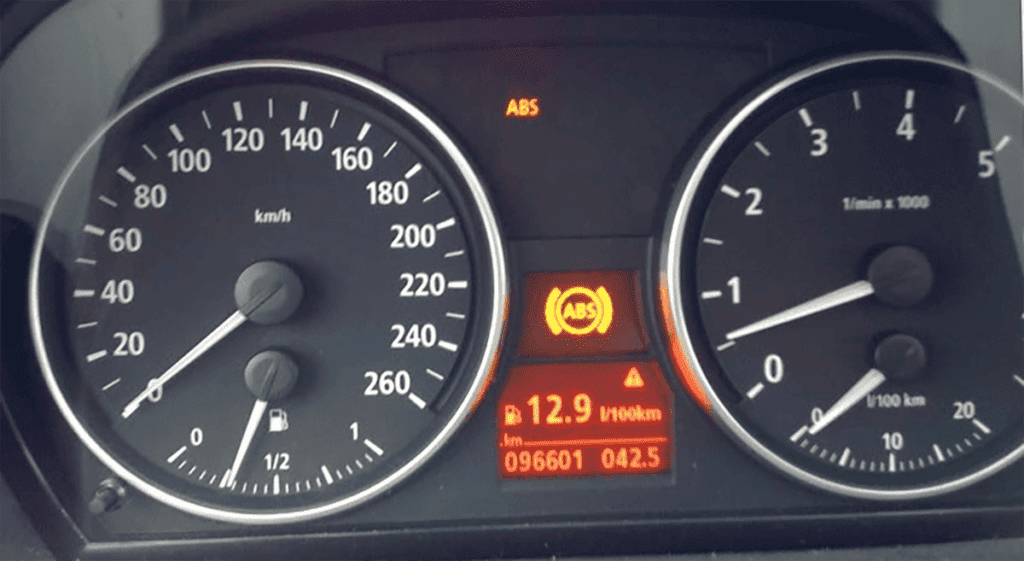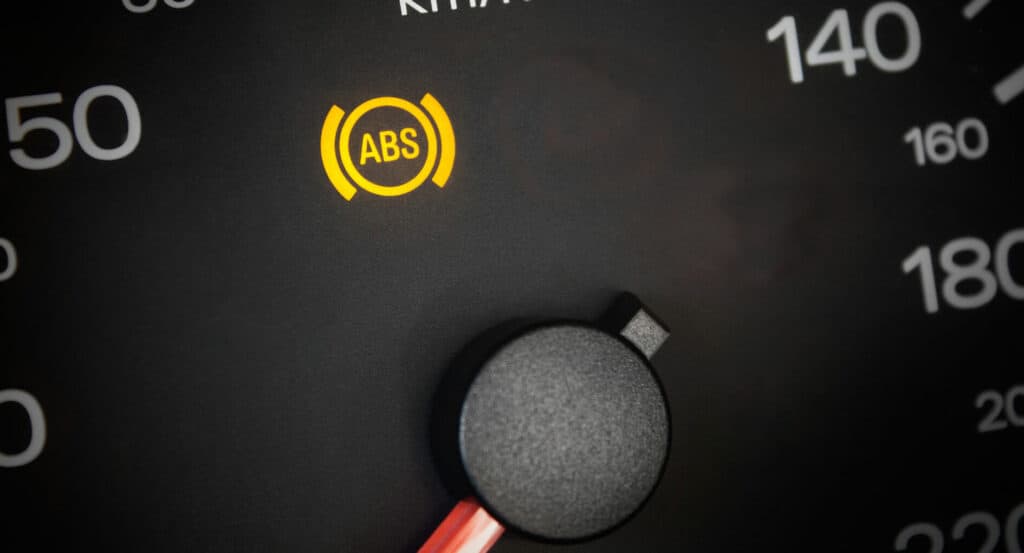Setting the Stage – Unraveling the ABS Mystery
Navigating Canada’s picturesque highways, the last thing a driver wants is an unexpected surprise on their dashboard. One light, in particular, the ABS warning light, can raise questions and concerns. This glow signifies something about the vehicle’s Anti-lock Braking System (ABS), but what? Let’s delve into this pressing mystery.
ABS Explained: Beyond the Warning Glow
The ABS isn’t merely alphabet soup. It stands for Anti-lock Braking System, and its function is far more vital than its unassuming name might suggest. Picture this: you’re driving on a rainy Ontario day, and a squirrel dashes across the road. You slam on the brakes. Instead of skidding uncontrollably, your tires maintain their grip on the slippery surface, allowing you to steer safely around our furry friend. That’s the ABS in action. By preventing your wheels from locking up during sudden braking situations, the ABS ensures your tires maintain constant traction with the road, giving you greater control over the vehicle.
When the ABS warning illuminates, it’s your car’s way of whispering (or sometimes yelling) that something’s amiss in this crucial system. And given how the ABS acts as the unsung hero during those heart-stopping moments, it’s a warning that shouldn’t be brushed aside. The beacon’s glow is a clear sign, nudging you to take a moment and ensure everything is in tip-top shape, ready to protect you when it matters most.

Decoding the ABS Distress Signal: Common Causes
• Worn-Out Sensors: Over time, the sensors crucial for the ABS system to function effectively can wear out or become damaged. Regular wear and tear or exposure to harsh conditions can lead to this.
• Faulty Fuses: Just like your home’s electronics, cars also rely on fuses. If a fuse related to the ABS system blows or malfunctions, it can directly impact the system’s operation and trigger the warning light.
• Hydraulic Issues: The ABS is more than just sensors and fuses. It’s intricately tied to the vehicle’s hydraulic system. Problems here, like leaks or air pockets, can compromise the ABS’s efficiency.
• Erroneous Wheel Speed Readings: Sometimes, the ABS system might get false or erratic wheel speed readings, which can cause it to think there’s a problem, illuminating the warning light.
• Damaged Wiring: The wiring connecting various parts of the ABS system is vital. Any damage, be it due to external factors or aging, can lead to the warning light coming on.
• Dirty or Contaminated Brake Fluid: The brake fluid plays an essential role in the ABS system. If it becomes dirty or contaminated, it can reduce the system’s effectiveness, signaling a warning.
• Age of the Vehicle: As vehicles age, various components can naturally degrade. Older vehicles might experience more frequent ABS issues due to the longevity of their parts.
• External Factors: Factors like extreme temperature drops, exposure to water or mud, or even minor collisions can impact the ABS system temporarily or permanently.
• Response to the Shout-Out: When the car’s ABS light is on, it’s essentially communicating a potential issue. Addressing the problem promptly ensures safety and can prevent more significant issues down the line.
Light On, But All Seems Well: The Paradox of the ABS Warning
Imagine cruising through Ontario’s picturesque landscapes, the sun shining brightly overhead, your favorite tunes on the radio, and everything seems perfect. But there’s just one thing out of place: the pesky ABS warning light that’s on. You step on the brakes, and everything feels as smooth as ever. The paradox? It’s possible that a minor system glitch or a temporary sensor misread has triggered this light. Even if your brakes respond perfectly, this light suggests a potential underlying issue that shouldn’t be ignored.
As much as we’d love to trust our intuition and the feel of the drive, our cars have intricate systems working in the background. These systems are designed to alert us even when potential problems are just beginning to manifest. So, while your drive might seem impeccable, and there might not be an evident issue, it’s always a good idea to get that light checked. It ensures that minor hitches don’t evolve into major problems down the road.
From Initial Hunches to In-depth Analysis: Checking Your ABS
1. Beginning with the Basics: Before diving deep, start with the most straightforward approach. A simple visual inspection of the vehicle can sometimes reveal obvious problems. It’s akin to spotting an open faucet when you’re trying to figure out why the water bill skyrocketed.
2. Wheel Sensor Examination: The wheel speed sensors play a crucial role in the ABS system. By checking these sensors, you can ensure they are free from debris, corrosion, or damage. A dirty sensor might just need a quick cleaning, while a damaged one requires replacement.
3. Harnessing Onboard Diagnostics: If visual inspection doesn’t reveal the culprit, delve deeper with the onboard diagnostic system. This system can provide specific error codes pointing to potential ABS issues. Think of it as the car’s way of communicating its internal concerns.
4. Professional Diagnostic Tools: For those who are tech-savvy, there are specialized ABS diagnostic tools available. These gadgets can read ABS-specific error codes, offering a more comprehensive insight into the problem.
5. Mobile Mechanics to the Rescue: Not everyone is comfortable diving deep into car diagnostics. For those asking, “How do you check ABS on a car?”, mobile mechanics like the team at Uchanics bring specialized equipment and expertise right to your doorstep. This ensures a thorough, professional ABS system check without the hassle of visiting a garage.
6. Acting on Diagnostic Insights: After identifying the potential ABS issue, it’s essential to act. Whether it’s a simple sensor cleaning or more intricate hydraulic repairs, addressing the problem early can save both money and potential future hassles.
Safe or Not? Gauging the Risk of an Illuminated ABS Light
The glow of the ABS warning light immediately plunges many drivers into a sea of questions, with the most pressing one being: “Is my vehicle safe to drive?” If the light remains steady without any accompanying sounds or noticeable changes in brake performance, you might be able to continue your journey for a short while. It’s akin to walking with a tiny pebble in your shoe — uncomfortable, but manageable for a short distance.
However, there’s a caveat. This light indicates a potential malfunction in your vehicle’s anti-lock braking system. Even if the car feels fine, the anti-lock feature, designed to prevent skidding during sudden brakes, might be compromised. It’s always better to err on the side of caution. The next step? Schedule a visit to a trusted mechanic (like the experts at Uchanics) to ensure that your braking system is in optimal condition, guaranteeing you peace of mind for all your future drives.
ABS Light Remedies: Repair Routes and Cost Destinations
As with most car repairs, costs fluctuate based on the severity of the issue:
Sensor Solutions
• Cleaning: Often, ABS sensors accumulate dirt and grime. A simple clean-up might be all that’s needed to turn off that glaring ABS light.
• Replacement: Sensors, being electronic components, can sometimes fail. Replacement is straightforward but ensures you use quality parts for longevity.
Hydraulic System Repairs
• Pump Issues: A malfunctioning ABS pump can cause the warning light to come on. Replacement might be required, but it’s generally more on the costly side.
• Fluid Leaks: Brake fluid leaks in the ABS system can be a culprit. Checking brake lines and the ABS modulator for leaks is essential.

Electronic Control Unit (ECU) Glitches
• Software Updates: Occasionally, the ABS system might require updated software to function properly.
• Hardware Malfunctions: The ECU might have hardware issues that need rectification. This isn’t a common occurrence but is a possibility.
Fuse and Wiring Issues
• Blown Fuses: A simple fuse replacement might be the solution for some.
• Wiring Inspections: Damaged or frayed wires can interrupt the ABS system. An inspection can identify such issues.
Cost Considerations
• Variable Prices: Depending on the severity of the issue and the chosen repair facility, costs can vary. Always get an estimate before proceeding.
• DIY vs. Professional Repairs: Some might opt for DIY solutions for simpler issues, but always consider the value of expert diagnosis and repair, especially for complex concerns.
The Self-Resolving Scenario: Can the ABS Warning Dim on Its Own?
When it comes to the ABS warning light, it’s not always a consistent beacon of distress. Sometimes, it’s influenced by external factors. For instance, a sudden drop in temperature might affect the ABS sensors temporarily, leading to a transient alert. Once conditions stabilize, such as when the day warms up, the ABS light might just turn off on its own, giving drivers a sigh of relief.
However, it’s not always sunshine and rainbows. While the ABS light might go off occasionally due to benign reasons, consistent illumination is a clarion call. If you notice the light turning on and off intermittently over extended periods, this could signal an underlying issue that’s only manifesting periodically. Such behavior warrants a thorough check to ensure all ABS components are functioning optimally.
Ignoring the Beacon: The Ramifications of Overlooking the ABS Alert
It’s easy to fall into the trap of complacency when a warning light doesn’t immediately translate to tangible issues. Some might think, “My car still brakes fine, why worry about the ABS light?” But, much like ignoring a minor toothache only for it to evolve into a root canal scenario, overlooking the ABS warning light can lead to compounded issues down the road.
Braking, especially in emergencies, is pivotal to vehicle safety. The ABS system ensures that during hard braking, the wheels don’t lock up, preserving steering control. By neglecting an illuminated ABS light, not only do drivers compromise the efficiency of this anti-lock feature, but they also risk cascading this problem into larger braking system issues. In the grand scheme, it’s not just about the car’s health; it’s a matter of personal safety and the safety of fellow road users.
Wrapping Up Our ABS Expedition
From understanding its essence to decoding its signals, we’ve blazed a trail through the ABS landscape. For every Ontario driver, knowledge is the key. When that ABS light beckons, face it with the confidence that you’re equipped to tackle the issue head-on. And if in doubt, always consider reaching out to Uchanics, your mobile mechanic solution in Canada, ready to assist with any ABS concerns.
